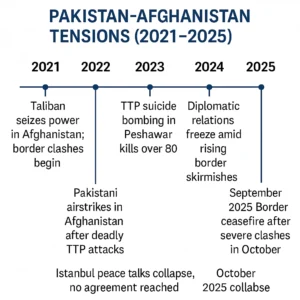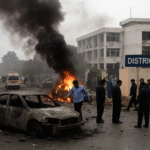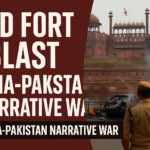Let’s be honest — most people weren’t expecting miracles from the latest Pakistan–Afghanistan talks in Istanbul. But still, there was hope.
Hope that after weeks of border clashes and deadly attacks, both sides might finally agree on a plan to stop the violence.
Instead, after four tense days, the delegations walked away empty-handed.
No agreement. No roadmap. Just sharper words and deeper mistrust.
This was supposed to be the “last-ditch push” to reset relations. Instead, it ended up showing how far apart the two neighbors really are.
⚠️ What Actually Happened Behind Closed Doors
According to officials from both sides, the talks were intense but unproductive.
Pakistan’s team, led by senior ministers and security advisors, pushed for one key demand: “End TTP operations from Afghan soil.”
Afghanistan’s representatives pushed back, saying Pakistan should stop airstrikes inside Afghan territory and respect their sovereignty.
For a moment, there was cautious optimism — until, reportedly, Kabul’s leadership changed its stance mid-talks, killing whatever progress had been made.
By the final day, Pakistan’s Information Minister openly admitted that the talks “failed to bring any workable solution.”
And just like that, the last flicker of hope faded.
🔍 Why the Talks Collapsed — The Real Story
Let’s break it down simply.
These talks didn’t fail because of one big argument — they failed because both sides are trapped in an old cycle of mistrust.
1️⃣ Terror Safe Havens
Pakistan believes the Tehrik-e-Taliban Pakistan (TTP) is being sheltered across the border. The group has claimed multiple attacks inside Pakistan this year.
Kabul insists those militants are beyond its control — a claim Pakistan doesn’t buy anymore.
2️⃣ Cross-Border Strikes
When Pakistan hits suspected TTP camps inside Afghanistan, Kabul calls it a “violation of sovereignty.”
Islamabad calls it “self-defense.”
It’s a blame game that keeps going in circles.
3️⃣ Trust Deficit
The truth is, there’s no trust left. Pakistan wants actions it can verify. Afghanistan says verification equals humiliation.
It’s like trying to build peace on quicksand.

🧨 For Pakistan — Diplomacy Meets Its Limit
For Islamabad, this breakdown feels like the final straw.
Officials say over 400 Pakistanis have been killed in attacks linked to militants coming from Afghan territory this year alone.
That’s why the government is now openly warning that if diplomacy fails, “other options are on the table.”
Realistically, those “options” could include:
•Limited air operations against TTP hideouts,
•A reinforced border crackdown,
•Or even support for anti-Taliban factions to pressure Kabul.
But any of those moves come with risks — more tension, more casualties, and possibly, more isolation on the global stage.
🕋 For Afghanistan — A Test of Control and Credibility
For the Taliban government, this is a serious credibility problem.
They’ve built their political identity around restoring “security and stability.” But if the TTP keeps using Afghan land to attack Pakistan, it shows they’re not fully in control.
Inside Afghanistan, the Taliban leadership is also split — some want to calm ties with Pakistan for trade and aid, others refuse to “bow” to Islamabad.
That’s the dilemma: every move toward peace with Pakistan risks angering their hardliners at home.
🌐 Regional Ripple Effects
When Pakistan and Afghanistan clash, it’s never just about them.
•China and Iran are quietly worried. Instability near their borders threatens their own projects and trade routes.
•Turkey and Qatar — the mediators — are frustrated that their diplomatic investment led nowhere.
•India, on the other hand, quietly benefits from the distraction. A tense western border keeps Pakistan’s attention split.
If the situation keeps sliding, regional extremists could use the chaos to regroup — and that’s everyone’s nightmare scenario.
🔮 What Could Happen Next
No one expects a full-blown war — but limited escalations? Absolutely possible.
Here’s what might come next:
1.Pakistan tightens the border — stricter crossings, increased surveillance.
2.Fresh back-channel diplomacy — intelligence-level talks away from cameras.
3.New mediation effort — maybe China or Qatar stepping in again.
4.Tactical military pressure — Pakistan signaling consequences if attacks continue.
Still, the best-case scenario is dialogue — not destruction.
Because honestly, both sides have too much to lose and nothing left to prove.
💡 What Could Actually Work This Time
If I were to suggest a realistic path forward, here’s what might make a difference:
•Joint border monitoring — small team, equal control, neutral oversight.
•Exchange of actionable intel instead of blaming each other.
•Reopen trade routes — economics builds trust faster than politics.
•Mutual public commitment — no threats, no propaganda.
These are simple steps, but history shows that’s how lasting peace usually begins — one practical move at a time.
🙋♂️ FAQs — People Also Ask
1. Why did the Pakistan–Afghanistan talks fail?
Because both sides refused to compromise — Pakistan wants TTP action; Afghanistan wants sovereignty respected.
2. What’s the TTP’s role in this?
The Tehrik-e-Taliban Pakistan operates from Afghan territory and targets Pakistan. Their presence is the main source of tension.
3. Could there be another round of talks?
Yes, if mediators like Qatar or China push for it — but trust needs rebuilding first.
4. Is war a real possibility?
Not likely a full war, but more border clashes and limited strikes are very possible.
🧾 Final Thoughts
These talks were supposed to heal wounds instead, they reopened old ones.
The border between Pakistan and Afghanistan is more than just a line on a map. It’s a mirror reflecting decades of mistrust, fear, and unfinished business.
But here’s the thing: no country wins from instability. Pakistan wants peace at its borders; Afghanistan wants respect for its sovereignty. The solution lies somewhere in between.
If both sides can replace suspicion with strategy, the next “last-ditch push” might actually succeed.
🕊 This article will be updated regularly as new developments emerge.










